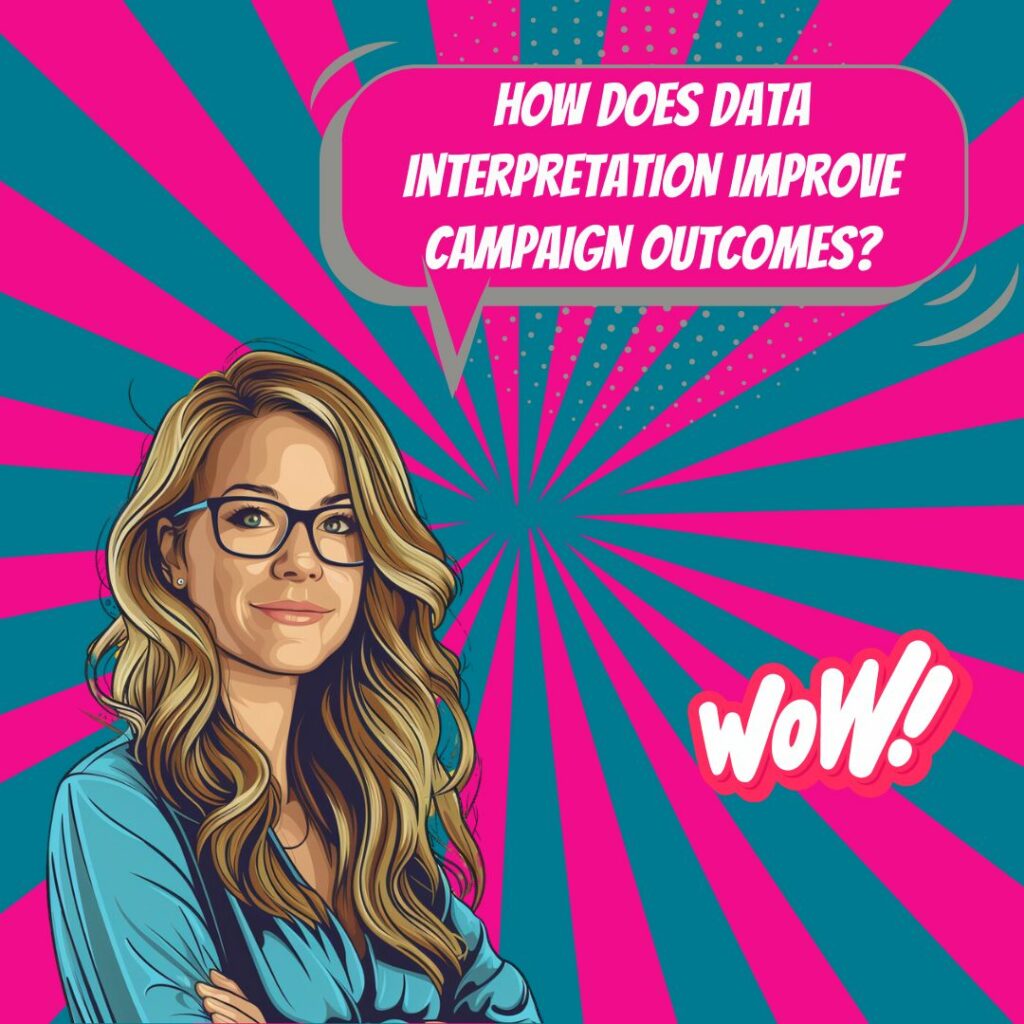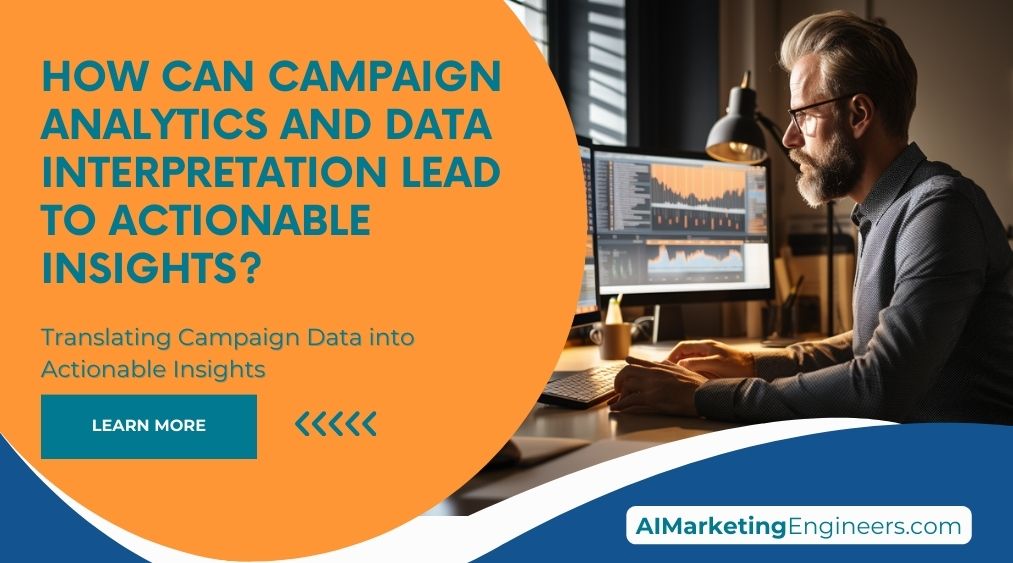Key Takeaways
✅ Enhanced Decision-Making: Utilizing campaign analytics significantly improves decision-making processes. According to a survey by Deloitte, 49% of companies say that data analytics helps them make better decisions, resulting in a 10% increase in profitability. By interpreting campaign data effectively, businesses can make informed choices that drive better outcomes and optimize their marketing strategies.
✅ Personalized Marketing: Data interpretation enables personalized marketing, which can substantially boost customer engagement and satisfaction. A report by Epsilon indicates that 80% of consumers are more likely to purchase from brands that offer personalized experiences. Leveraging campaign insights to tailor content and offers to individual preferences can lead to higher conversion rates and stronger customer loyalty.
✅ Identifying Growth Opportunities: Campaign analytics help identify new growth opportunities by revealing trends and patterns in customer behavior. McKinsey & Company found that companies using customer analytics extensively are more likely to outperform their competitors by 85% in sales growth. By analyzing campaign data, businesses can uncover untapped markets, optimize their marketing spend, and drive sustained growth.

Introduction
In today’s data-driven world, the power of campaign analytics and data interpretation cannot be overstated. Imagine having the ability to see through the noise and pinpoint exactly what drives your audience to act. Campaign analytics transform vast amounts of data into clear, actionable insights, guiding businesses to make smarter, more strategic decisions. This capability not only enhances marketing effectiveness but also drives profitability, ensuring that every marketing dollar is well spent. By delving into the nuances of campaign performance, marketers can uncover hidden patterns and trends, enabling them to fine-tune their strategies for maximum impact.
Consider the competitive advantage gained from personalized marketing experiences. With data interpretation, businesses can move beyond generic campaigns and deliver tailored content that resonates with individual customers. This level of personalization is no longer a luxury; it’s a necessity in an age where consumers expect brands to understand and cater to their unique preferences. Furthermore, analytics provide a roadmap for identifying new growth opportunities, revealing insights that might otherwise go unnoticed. By harnessing the power of campaign analytics, businesses can not only stay ahead of the competition but also foster deeper connections with their audience, driving long-term success.
Top Statistics
| Statistic | Insight |
|---|---|
| Global Data Analytics Market Growth: Expected to grow from $27.3 billion in 2021 to $103.6 billion by 2028. | This rapid growth signifies the increasing reliance on data to drive business decisions and strategies. |
| Increased Demand for Data-Driven Decision-Making: 92% of business leaders emphasize its importance. | This statistic underscores the essential role that data analytics plays in shaping organizational strategies. |
| Personalization and Targeting: 80% of consumers are more likely to make a purchase with personalized experiences. | The high percentage highlights the critical importance of tailored marketing in enhancing customer engagement. |
| AI and Machine Learning Market Growth: Projected to rise from $387.45 billion in 2022 to $1,394.30 billion in 2029. | This indicates a surge in adoption of AI technologies, suggesting a transformative impact on business automation and insights. |
| Social Media Insights: 73% of marketers find social media marketing effective. | The statistic highlights the value of social media in connecting with and understanding the consumer base. |
Collecting and Organizing Data
In the realm of modern marketing, understanding where your data comes from is crucial. Key data sources include website analytics, social media interactions, and direct customer feedback. Each of these streams provides a wealth of information but sifting through them without a structured approach can be daunting. Organizing this data effectively is the first step towards clear analysis. For instance, cleaning data by removing duplicates or correcting errors ensures reliability. Organized data sets the foundation for insightful analysis, helping marketers to make informed decisions.
Identifying Key Performance Indicators (KPIs)
Selecting the right KPIs is essential for measuring the effectiveness of marketing campaigns. These indicators should align closely with your campaign objectives. Common KPIs include the conversion rate, which measures how many people took a desired action; the engagement rate, which reflects interaction with your content; and customer acquisition cost, which calculates the expense involved in gaining a new customer. Correctly identifying and tracking these KPIs can provide clear benchmarks for success and areas needing adjustment.
Data Visualization and Analysis
Visual representation of data not only simplifies complex information but also highlights patterns that might not be obvious from raw data alone. Tools like line charts, bar graphs, and heatmaps can reveal trends and outliers effectively. Coupling these tools with robust statistical methods allows marketers to derive meaningful insights. For example, regression analysis can help understand which factors most influence customer behavior, offering a roadmap for targeted adjustments in campaign strategies.
Turning Insights into Action
The real power of data insights lies in their application. Translating these insights into actionable decisions can tremendously impact the effectiveness of your campaigns. If data shows that a particular demographic responds positively to specific messaging, marketers can focus more resources on these areas. Similarly, insights from A/B testing can lead to refined messaging or even exploring new marketing channels, ultimately leading to increased ROI.
Continuous Improvement and Learning
The marketing landscape is ever-evolving, and so should be the strategies based on data insights. Continuous learning from ongoing campaigns is vital. Regularly employing A/B testing, for instance, helps identify what works best and what doesn’t. Furthermore, regular updates and reports keep stakeholders informed and ensure that everyone is aligned with the latest insights and adjustments. This cycle of testing, learning, and improving is essential for staying competitive and achieving sustained success.
By embracing a thorough and dynamic approach to campaign insights and data interpretation, marketers can ensure their strategies are not only reactive but also proactive, leading to more successful outcomes and a robust marketing presence.
AI Marketing Engineers Recommendation
Recommendation 1: Utilize Segmentation to Enhance Customer Insights: How Can Campaign Insights and Data Interpretation Provide Actionable Insights? By using segmentation, businesses can dive deep into their campaign data to understand various customer demographics and behaviors. For instance, a recent study by McKinsey showed that campaigns targeted at specific segments can increase ROI by up to 200%. By breaking down data by age, location, purchasing habits, and more, companies can tailor their marketing strategies to better meet the needs of each segment, thus boosting engagement and conversions.
Recommendation 2: Adopt Predictive Analytics for Forecasting Future Trends: Financial decisions should not just be reactive but proactive. How Can Campaign Insights and Data Interpretation Provide Actionable Insights? By leveraging predictive analytics. This approach involves using historical data to forecast future behavior, trends, and outcomes. For example, businesses can analyze past marketing campaigns to predict customer responses to similar future campaigns, thereby optimizing their marketing spend and strategy. Companies using predictive analytics have reported up to a 25% reduction in marketing costs while improving campaign performance by up to 20%.
Recommendation 3: Implement Real-Time Data Dashboards for Immediate Adjustments: In today's fast-paced market, the ability to quickly adapt is crucial. How Can Campaign Insights and Data Interpretation Provide Actionable Insights? Through real-time data dashboards. These tools provide immediate access to campaign performance metrics, allowing marketers to make swift adjustments. For instance, if an ad is underperforming in certain regions, it can be tweaked or halted to minimize losses. Studies suggest that marketers who use real-time data can enhance their campaign effectiveness by up to 30% compared to those who do not.
Relevant Links
- Maximize Your Affiliate Marketing Success in 2022!
- AI Revolution in Marketing: Are You Ready?
- Crafting Top-Performing Google Ads with AI
- Stay Ahead: Top Digital Marketing Trends 2024
- Unlocking Business Growth with AI Tools
Conclusion
In the landscape of modern marketing, the value of data-driven decision-making cannot be overstated. Through the careful collection, organization, analysis, and interpretation of data, businesses can transform raw numbers into actionable insights that drive success. By identifying the right Key Performance Indicators (KPIs), utilizing sophisticated data visualization techniques, and continuously learning from each campaign, companies can significantly enhance their strategic actions and outcomes.
The ability to turn insights into effective action is perhaps the most critical takeaway. It ensures that every campaign is better than the last, honing in on what truly resonates with audiences. From refining ad messages to optimizing distribution channels, the insights garnered from data interpretation are pivotal. Moreover, the practice of continuous improvement through methods like A/B testing enables not just growth but adaptability—an essential trait in today’s rapidly changing market environments.
As you move forward, embrace the integration of these practices into your marketing strategy. Allow the rich insights derived from meticulous data analysis to lead your campaign decisions. Remember, in a world inundated with data, the ability to sift through the noise and find meaningful information is more than a skill—it’s a competitive advantage. Encourage a culture where data-driven insights foster continuous learning and improvement. Let’s not just chase numbers, but strive to understand the story they tell and the paths they illuminate.
FAQs
Question 1: What are campaign insights and data interpretation in marketing?
Answer: Campaign insights refer to the valuable information gathered from analyzing marketing campaigns, while data interpretation involves making sense of this information to derive meaningful conclusions.
Question 2: Why are campaign insights and data interpretation important?
Answer: Campaign insights and data interpretation are crucial for understanding the effectiveness of marketing strategies; identifying areas for improvement, and making data-driven decisions to optimize future campaigns.
Question 3: What types of data can be collected during a marketing campaign?
Answer: Data collected during a marketing campaign can include website traffic, engagement metrics (likes, comments, shares), conversion rates, customer behavior, demographics, and feedback from surveys or customer reviews.
Question 4: How can campaign insights and data interpretation provide actionable insights?
Answer: By analyzing campaign data, marketers can identify patterns, trends, and correlations, which can inform decisions about optimizing content, targeting specific audiences, adjusting campaign goals, and allocating resources more effectively.
Question 5: What are some common metrics used to measure the success of a marketing campaign?
Answer: Common metrics used to measure the success of a marketing campaign include click-through rates (CTR), conversion rates, return on investment (ROI), cost per acquisition (CPA), customer lifetime value (CLV), and engagement rates (likes, comments, shares).
Question 6: How can marketers use campaign insights and data interpretation to improve customer experience?
Answer: By understanding customer behavior and preferences through data interpretation, marketers can tailor their campaigns to provide a more personalized and engaging experience, leading to increased customer satisfaction and loyalty.
Question 7: What are some best practices for collecting and analyzing campaign data?
Answer: Best practices for collecting and analyzing campaign data include setting clear campaign goals, using reliable data collection tools, cleaning and organizing data, using data visualization tools, and regularly reviewing and updating data analysis strategies.
Question 8: How can marketers use advanced data analytics techniques to gain deeper insights into their campaigns?
Answer: Advanced data analytics techniques, such as machine learning, predictive modeling, and natural language processing, can help marketers gain deeper insights into customer behavior and preferences, enabling them to make more accurate predictions and optimize their campaigns more effectively.
Question 9: What are some common challenges associated with campaign insights and data interpretation?
Answer: Common challenges associated with campaign insights and data interpretation include data quality issues, data overload, lack of data expertise, difficulty in identifying meaningful insights, and difficulty in translating insights into actionable strategies.
Question 10: How can marketers stay up-to-date with the latest trends and best practices in campaign insights and data interpretation?
Answer: Marketers can stay up-to-date with the latest trends and best practices in campaign insights and data interpretation by attending industry conferences, reading industry publications, participating in online communities, and investing in ongoing training and development opportunities.





